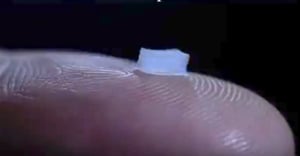The dream is to eventually 3D print a spinal cord scaffold layered with viable neurons that can be implanted into a human spinal cord and rebuild damaged neural connections and restore mobility to people with spinal cord injuries.
The dream took a giant step forward recently as researchers at the University of Minnesota announced they had produced a 3D-printed guide made of silicone that serves as a platform for growing neuronal stem cells.
The researchers envision the guide will be surgically implanted into the injured area of the spinal cord where it will act like a scaffold allowing 3D-printed living nerve cells layered onto the scaffold to grow together from above and below the injured area. The study was published in August 2018 in the journal Advanced Functional Materials.
The two-step process starts with any cell type from an adult, such as a skin or blood cell. Using bioengineering techniques, the cells are reprogrammed into neuronal stem cells. These are then layered onto a silicone guide using 3D-printing technology in which the same printer is used to print both the scaffold and the cells. The guide keeps the cells alive and allows them to change into neurons. The scaffold is then surgically implanted into the damaged area of the spine.
While an implant into a human will require much more research, the study showed it is feasible.
"This is the first time anyone has been able to directly 3D print neuronal stem cells derived from adult human cells on a 3D-printed guide and have the cells differentiate into active nerve cells in the lab," Michael McAlpine, Ph.D., a co-author of the study and University said in a press release.
The researchers said the most difficult part of the process is to print the living cells and keep them alive. The process outlined in the journal study is able to keep about 75 percent of the cells alive during the 3D-printing process and then have them turn into healthy neurons.
Should the process prove successful in humans, the proposed treatment could be life changing for the estimated 285,000 people in the U.S. with spinal cord injuries.
"This is a very exciting first step in developing a treatment to help people with spinal cord injuries," Ann Parr, M.D., Ph.D., co-author of the study said in a press release. "Currently, there aren't any good, precise treatments for those with long-term spinal cord injuries.
“We've found that relaying any signals across the injury could improve functions for the patients. There's a perception that people with spinal cord injuries will only be happy if they can walk again. In reality, most want simple things like bladder control or to be able to stop uncontrollable movements of their legs. These simple improvements in function could greatly improve their lives."
Kapstone Medical is a full-service product realization firm that partners with inventors and manufacturers of all sizes to rapidly develop and commercialize new medical devices or processes. We love sharing the latest news in 3D printing and what’s going on in the MedTech Industry. For more information contact us today at (704) 843-7852 – or by email at info@kapstonemedical.com.
Sources: Advance Functional Materials, Aug. 9, 2018, https://doi.org/10.1002/adfm.201801850 and University of Minnesota press release.



